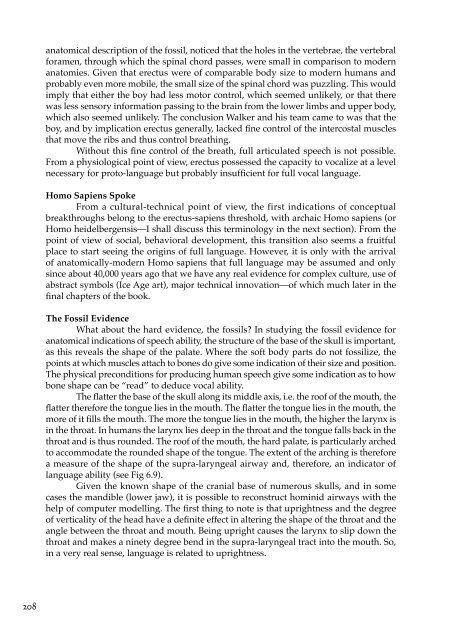The Spirit in Human Evolution - Waldorf Research Institute
The Spirit in Human Evolution - Waldorf Research Institute
The Spirit in Human Evolution - Waldorf Research Institute
You also want an ePaper? Increase the reach of your titles
YUMPU automatically turns print PDFs into web optimized ePapers that Google loves.
anatomical description of the fossil, noticed that the holes <strong>in</strong> the vertebrae, the vertebral<br />
foramen, through which the sp<strong>in</strong>al chord passes, were small <strong>in</strong> comparison to modern<br />
anatomies. Given that erectus were of comparable body size to modern humans and<br />
probably even more mobile, the small size of the sp<strong>in</strong>al chord was puzzl<strong>in</strong>g. This would<br />
imply that either the boy had less motor control, which seemed unlikely, or that there<br />
was less sensory <strong>in</strong>formation pass<strong>in</strong>g to the bra<strong>in</strong> from the lower limbs and upper body,<br />
which also seemed unlikely. <strong>The</strong> conclusion Walker and his team came to was that the<br />
boy, and by implication erectus generally, lacked f<strong>in</strong>e control of the <strong>in</strong>tercostal muscles<br />
that move the ribs and thus control breath<strong>in</strong>g.<br />
Without this f<strong>in</strong>e control of the breath, full articulated speech is not possible.<br />
From a physiological po<strong>in</strong>t of view, erectus possessed the capacity to vocalize at a level<br />
necessary for proto-language but probably <strong>in</strong>sufficient for full vocal language.<br />
Homo Sapiens Spoke<br />
From a cultural-technical po<strong>in</strong>t of view, the first <strong>in</strong>dications of conceptual<br />
breakthroughs belong to the erectus-sapiens threshold, with archaic Homo sapiens (or<br />
Homo heidelbergensis—I shall discuss this term<strong>in</strong>ology <strong>in</strong> the next section). From the<br />
po<strong>in</strong>t of view of social, behavioral development, this transition also seems a fruitful<br />
place to start see<strong>in</strong>g the orig<strong>in</strong>s of full language. However, it is only with the arrival<br />
of anatomically-modern Homo sapiens that full language may be assumed and only<br />
s<strong>in</strong>ce about 40,000 years ago that we have any real evidence for complex culture, use of<br />
abstract symbols (Ice Age art), major technical <strong>in</strong>novation—of which much later <strong>in</strong> the<br />
f<strong>in</strong>al chapters of the book.<br />
<strong>The</strong> Fossil Evidence<br />
What about the hard evidence, the fossils? In study<strong>in</strong>g the fossil evidence for<br />
anatomical <strong>in</strong>dications of speech ability, the structure of the base of the skull is important,<br />
as this reveals the shape of the palate. Where the soft body parts do not fossilize, the<br />
po<strong>in</strong>ts at which muscles attach to bones do give some <strong>in</strong>dication of their size and position.<br />
<strong>The</strong> physical preconditions for produc<strong>in</strong>g human speech give some <strong>in</strong>dication as to how<br />
bone shape can be “read” to deduce vocal ability.<br />
<strong>The</strong> flatter the base of the skull along its middle axis, i.e. the roof of the mouth, the<br />
flatter therefore the tongue lies <strong>in</strong> the mouth. <strong>The</strong> flatter the tongue lies <strong>in</strong> the mouth, the<br />
more of it fills the mouth. <strong>The</strong> more the tongue lies <strong>in</strong> the mouth, the higher the larynx is<br />
<strong>in</strong> the throat. In humans the larynx lies deep <strong>in</strong> the throat and the tongue falls back <strong>in</strong> the<br />
throat and is thus rounded. <strong>The</strong> roof of the mouth, the hard palate, is particularly arched<br />
to accommodate the rounded shape of the tongue. <strong>The</strong> extent of the arch<strong>in</strong>g is therefore<br />
a measure of the shape of the supra-laryngeal airway and, therefore, an <strong>in</strong>dicator of<br />
language ability (see Fig 6.9).<br />
Given the known shape of the cranial base of numerous skulls, and <strong>in</strong> some<br />
cases the mandible (lower jaw), it is possible to reconstruct hom<strong>in</strong>id airways with the<br />
help of computer modell<strong>in</strong>g. <strong>The</strong> first th<strong>in</strong>g to note is that uprightness and the degree<br />
of verticality of the head have a def<strong>in</strong>ite effect <strong>in</strong> alter<strong>in</strong>g the shape of the throat and the<br />
angle between the throat and mouth. Be<strong>in</strong>g upright causes the larynx to slip down the<br />
throat and makes a n<strong>in</strong>ety degree bend <strong>in</strong> the supra-laryngeal tract <strong>in</strong>to the mouth. So,<br />
<strong>in</strong> a very real sense, language is related to uprightness.<br />
208
















